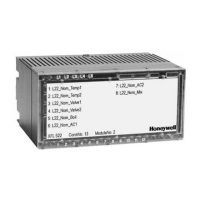EXCEL CARE CONTROL ICONS ALPHABETIC REFERENCE
55 74-5577–33 (US)
EN2B-0184 GE51 R0518 (Europe)
When zone temperature is within the comfort zone limits, DUC continuously
calculates off time. Off time is inversely proportional to the deviation of a zone
temperature from the setpoint. Off time reaches its maximum (P4) when zone
temperature is equal to the setpoint, that is, X1 = X2 = X4. If X1 is not equal to X2,
DUC sets a shorter off time. The following formula defines this relationship (a
straight line y with gradient m through a known point P(x0/y0)):
Y = m*(X-X0)+y0 where m = y/x.
The following example uses this formula to calculate the corresponding equations
for the actual off times.
DUC Example This example describes off time calculation for the three types of systems (heating,
cooling, and heating and cooling). Basic requirements for each system type are the
same:
Highest zone temperature X1 = 73F (23C)
Lowest zone temperature X2 = 64F (18C)
Setpoint X4 = 68F (20C)
Temperature difference P3 = 7 F Deg (4K)
Maximum off time P4 = 50 percent
Minimum off time P5 = 5 percent
Cycle time P6 = 60 min
Single-stage fan
These values create the following parameters:
Lower comfort limit (LCL) = X4 - P3 = 68 - 7 = 61
Upper comfort limit (UCL) = X4 + P3 = 68 + 7 = 75
Maximum off time in minutes (t
max
) = P4 * P6 = 60 * .50 = 30 min
Minimum off time in minutes (t
min
) = P5 * P6 = 60 * .05 = 3 min
Heating System Off Time Calculation
In heating-only systems, DUC calculates off time exclusively on lowest zone
temperature (X2) because heating is only required at the low end of the temperature
range.
If temperatures are above the setpoint, the system does not operate and DUC sets
off time to the maximum (t
max
).
If the minimum zone temperature is less than the lower comfort limit, off time is zero,
that is, the system is never cycled off.
When temperature is between the setpoint and the lower comfort limit, DUC
calculates heating off-time, t
off
, (YD1 or YD2 = 0) as:
DUC switches the heating system off 14.5 minutes before the end of the cycle.

